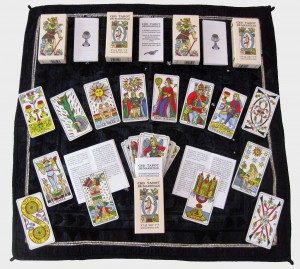 Available editions of the Tarot de Marseille are of two kinds: photocopies (or “facsimile”) and restored. Photocopies are exact copies of original 16th-19th Century decks. They are valuable for collectors. But after centuries of use and wear the colors of the original cards have faded and many line details are missing or unclear. This makes them unsuitable for actual reading.
Available editions of the Tarot de Marseille are of two kinds: photocopies (or “facsimile”) and restored. Photocopies are exact copies of original 16th-19th Century decks. They are valuable for collectors. But after centuries of use and wear the colors of the original cards have faded and many line details are missing or unclear. This makes them unsuitable for actual reading.
Tarot de Marseille readers often use restored editions. These are copies of old decks re-drawn in clear lines and vivid colors. CBD (“Conver – Ben-Dov”) Tarot de Marseille is a restored edition.
So, what’s special about CBD Tarot de Marseille?
The following sections describe the unique features of CBD Tarot de Marseille, compared to other restored editions. I don’t mean to claim that CBD Tarot de Marseille is necessarily “better” than others. Each edition may have its own strong and weak points. I just want to explain the choices that I took in the restoration – why I did things in such a way, and what effect this has on the cards’ appearance.
Jump directly to:
Details – Lines – Frames and Letters – Colors – Face Expressions – Irregularities – Art and Composition – Cardstock, Size, Cardback – License – Mistakes – The Blank Card
Details
The details of CBD Tarot de Marseille are faithfully copied from Nicholas Conver’s 1760 deck. This deck represents the final outcome of four centuries of evolution. Later, it became the best appreciated and most influential version of the traditional Tarot. Many Tarot authorities agree that its details express the magic of the age-old Tarot in its purest and most effective form.
Other restored editions popular among readers also rely on Conver’s deck. But often they supplement it with additional details whimsically picked from other decks. They also add to it new elements reflecting their creators’ personal ideas. CBD Tarot de Marseille respects Conver’s design. It is faithful to its details and lines, without trying to correct them or to improve on the original.
Read more about it in: New Marseille Decks
Lines
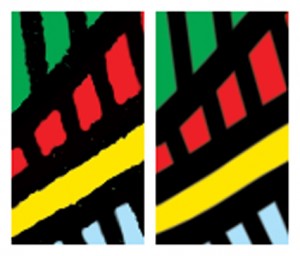
right: the same shapes in vector lines
and flood fill colors
Other restored decks often use “vector graphics” lines created by a computer. Such lines are uniform in width, unless given an artificial texture. Their curves are smooth and mathematically exact. The colors are usually added by “flood fill”. this means that they stop exactly at the line’s edge. This procedure saves a lot of time and effort. But in my feeling it gives the illustrations a sharp, crisp and too artificial appearance.
The black lines of the CBD Tarot de Marseille were produced in a slow, growing and organic process. First, the lines were drawn by hand using ink nib and tippex brush on paper. Later, they were scanned and re-shaped manually millimeter by millimeter. The work was done in a very high resolution, so that a full-sized card would be 3-1/2 Meters high. This required over 3-1/2 years and three pairs of hands. The lines were gradually shifted to correspond to the originals, while keeping a smooth, flowing quality. In this process, the lines have kept a non-uniform texture. This makes the colors blend gradually into the lines, as it was in the original hand-colored wood prints.
Read more about it in: the making of CBD Tarot
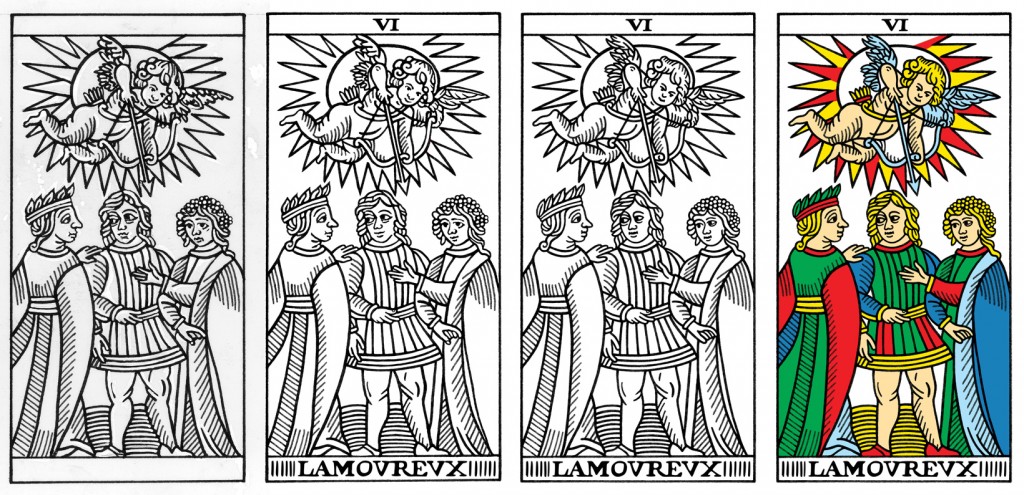
four stages in the illustration of a card, left to right: (click to enlarge)
1 – ink drawing by Leela Ganin
2 – cleaned and titled by Nir Matarasso
3 – final shaping by myself
4 – same as 3, with color
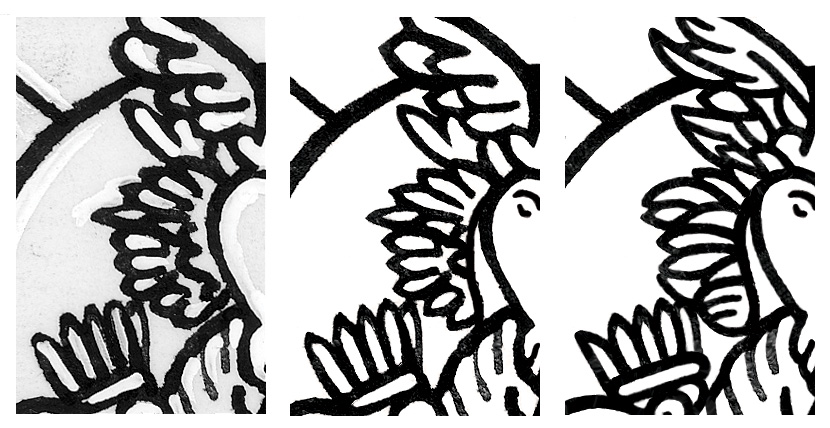
stages 1-3 (Leela, Nir, myself): detail in full resolution
Frames and Letters
The card frames in many restored decks are also computer-generated. Usually the frames are uniform – same frame for all the cards. Also, they are drawn in thick, perfectly straight and right-angled lines. In my view this makes the frames too visually dominant. The thick and uniform frame encloses each card in its own space, and gives it a square and schematic look.
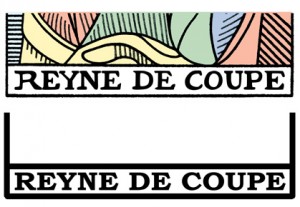
bottom: vector frame, font letters
(compare the four E’s)
The card frames in the CBD Tarot de Marseille were drawn by hand. Each card frame is unique, different from all the others. The frames are not exactly rectangular, preserving some of the irregularity of the original woodcuts. I just made them thinner, to compensate for the stronger shade of modern ink. This was done to keep the original balance between image and frame. In addition to the natural feel, the thin frame lines and the narrow borders also make it easier for cards to connect with each other. This feature is especially important in the open reading approach, in which we look at the composite spread and see it as a complete picture.
The same is true for the card titles and Roman numerals. In the original Conver deck, these were carved by hand. Some restored decks use a computer font with uniform and squarely placed letters. In the CBD Tarot de Marseille each letter is unique, with its shape and position manually copied from the original.
Colors
The line details in different versions of the Tarot de Marseille are usually quite similar. But there is a lot of variation in the coloring. The same object can be blue in one version, and red in another. Even in the Conver deck, the lines were printed over two centuries using the same original woodblocks. But the coloring templates were replaced every few years due to wear. Thus, the coloring scheme gradually became cruder and less detailed.
CBD Tarot de Marseille generally follows the coloring scheme of the earliest available Conver edition. This is a deck kept at the Bibliothèque Nationale in Paris. Its coloring is as close as possible to the artistic and symbolic intentions of the original master. This means, for example, that a red object in Conver’s design is also red in the CBD Tarot de Marseille.
Still, because of the different printing technique, I had to decide which shade I should use for each color. After many tests and adjustments I chose the present palette. I found it soft, harmonious, bringing out the artistic composition, and not “hiding” the printed lines as sometimes happens in other restored decks.
To be sure that the color shades were right I had the cards printed by CartaMundi, the biggest producer of playing cards in Europe. At the time of printing I travelled to Turnhout, Belgium, and personally monitored the printing machine’s calibration.
Face Expressions
In the CBD Tarot de Marseille I preserved the original face traits. This means that each human figure is “the same person” as in Conver’s deck. However, keeping the original face expressions would make a gloomy and depressing impression on the modern eye. This is because in those days, people were used to serious and heavy faces in portraits. To avoid such an effect I had to lighten up the expressions. I didn’t want to make them ridiculously happy, but just give them a calmer and more serene mood. I made many adjustments and ran test readings with different target groups. The resulting figures look alive, gazing at each other with feeling and creating emotional relationships between them.
Irregularities
A special challenge was the fact that in the Marseilles cards, and particularly in Conver’s deck, there are many anomalies and irregularities. There are, for example:
- Different figures and objects merging into each other.
- Ambiguous shapes which can be interpreted as parts of different objects.
- Irregular anatomical features or impossible perspectives.
- Coloring which breaks the shapes of objects or continues outside their borders.
- Inconsistencies in the spelling of card titles.
and so on.
Creators of other restored decks have often tended to “correct” such anomalies. But in the CBD Tarot de Marseille I preferred to keep them. In don’t consider them as arbitrary mistakes. Rather, I see them as an element of chaos consciously introduced to give the cards a dynamic and dream-like atmosphere. In my view, it is exactly the balance between order and chaos which gives the Tarot cards their mysterious power over people’s minds.
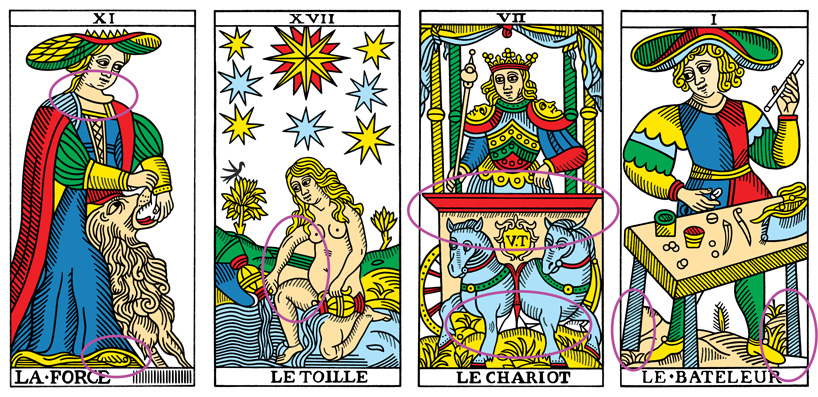
strange anatomical detail in The Force
painted background in The Star
asymmetry, color spill and unclear figures in The Chariot
missing ground at the edges in The Magician
Read more about: order and chaos in the Tarot cards.
Art and Composition
While working on the cards, I realized that what I am restoring is the work of an artistic genius. In my view, it is the interplay between art and symbolism which gave Conver’s Tarot its unique power, making it the recognized standard of the Marseille deck. The colored shapes are carefully arranged to create elaborate compositions and flow lines. These arrangements lead the eye across the card and help to connect neighboring cards. This gives the card illustrations an overall integrity and a feeling of movement.
The ingenious visual compositions are part of Conver’s design, as they emerge and become evident by copying exactly his lines and shapes. However, through wear and fade, they became gradually more difficult to perceive. With the CBD Tarot de Marseille restored in clear lines and vivid colors, we may again perceive and experience the art which gives Conver’s deck its magical power.
See some examples in this video:
Cardstock, Size, Cardback
The cardstock used for the CBD Tarot de Marseille is “Superluxe 320 grs with inline varnish”. This was the best one offered by CartaMundi. It is clear white, strong, durable and flexible. The cards slide smoothly when shuffled without being too “plastic glossy”. They are also thin enough to make the whole deck fit easily into the hand.
Each card measures 62×120 mm with round corners. The illustration frames (without borders) measure 57×114 mm. This is the average measure of card frames in the original Conver wood plates.
The cardback is a repetitive blue pattern on off-white background. The basic pattern was inspired by a medieval Andalusian tiling. I adapted and re-worked the pattern by hand until I got the desired effect: calm, neutral, not too dominant, but also not boring to the eye.
License
Most new decks are copyright protected. You need a permission to reproduce them – for example, in your website or as a basis for your own creation. Many decks also put a copyright mark on the cards, thereby adding a modern “commercial branding” element which, in my view, is alien to the traditional spirit of the original illustrations.
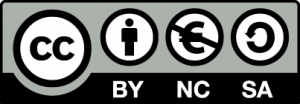
CBD Tarot de Marseille is open for use and distribution (non-commercial) under a Creative Commons license (CC BY-NC-SA 3.0) . Please feel free to share, use or distribute. For your convenience, you can download all the card illustrations as a single winzip file (two sizes in full color, plus the 22 majors as black-and-white line drawings) at the download page.
Mistakes
CBD Tarot de Marseille underwent many checks and revisions. And yet, there are still mistakes that remain in this edition. Most of them are probably still unknown to me. But I don’t see this as a big drawback. There never was “a perfect Tarot deck”, exactly as there is no “perfect horse” or “perfect human”. Each individual has its own bugs and quirks making it a living, evolving system. Tarot decks are no exception.
One such mistake I noticed only when the files were already submitted to print. This happened in spite of the cards’ having passed many checks and revisions. Can you spot the error at the upper interlacing mesh in the 6 of Swords?
The Blank Card
CBD Tarot de Marseille contains an additional open card with an empty frame. Shuffled with the deck or as a separate focusing tool, it allows for many possibilities, experiences and games.
Read here for some ideas about using the blank card, or play and invent your own..
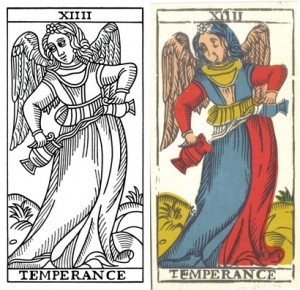
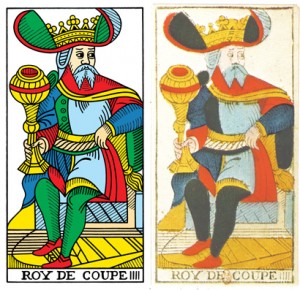
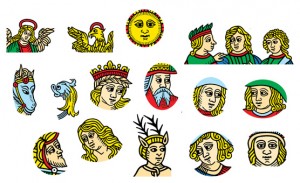
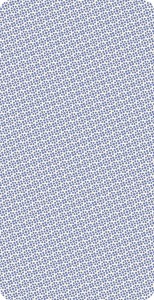
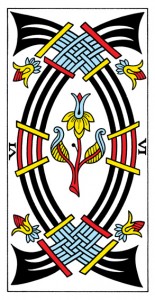
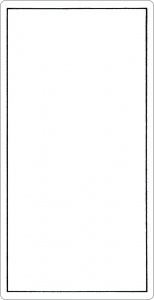
2 thoughts on “Features of CBD Tarot”
Comments are closed.